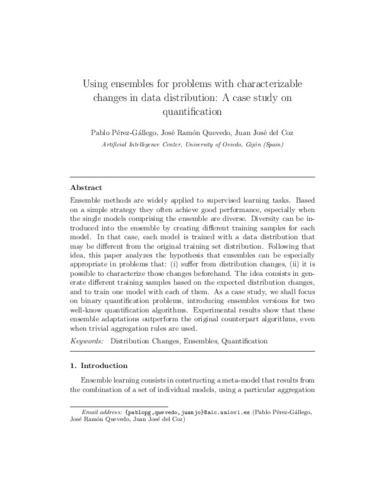Using ensembles for problems with characterizable changes in data distribution: A case study on quantification
Autor(es) y otros:
Palabra(s) clave:
Distribution changes
Ensembles
Quantification
Fecha de publicación:
Editorial:
Elsevier
Versión del editor:
Citación:
Descripción física:
Resumen:
Ensemble methods are widely applied to supervised learning tasks. Based on a simple strategy they often achieve good performance, especially when the single models comprising the ensemble are diverse. Diversity can be introduced into the ensemble by creating different training samples for each model. In that case, each model is trained with a data distribution that may be different from the original training set distribution. Following that idea, this paper analyzes the hypothesis that ensembles can be especially appropriate in problems that: (i) suffer from distribution changes, (ii) it is possible to characterize those changes beforehand. The idea consists in generating different training samples based on the expected distribution changes, and to train one model with each of them. As a case study, we shall focus on binary quantification problems, introducing ensembles versions for two well-known quantification algorithms. Experimental results show that these ensemble adaptations outperform the original counterpart algorithms, even when trivial aggregation rules are used
Ensemble methods are widely applied to supervised learning tasks. Based on a simple strategy they often achieve good performance, especially when the single models comprising the ensemble are diverse. Diversity can be introduced into the ensemble by creating different training samples for each model. In that case, each model is trained with a data distribution that may be different from the original training set distribution. Following that idea, this paper analyzes the hypothesis that ensembles can be especially appropriate in problems that: (i) suffer from distribution changes, (ii) it is possible to characterize those changes beforehand. The idea consists in generating different training samples based on the expected distribution changes, and to train one model with each of them. As a case study, we shall focus on binary quantification problems, introducing ensembles versions for two well-known quantification algorithms. Experimental results show that these ensemble adaptations outperform the original counterpart algorithms, even when trivial aggregation rules are used
ISSN:
Patrocinado por:
This research has been funded by MINECO (the Spanish Ministerio de Econom a y Competitividad) and FEDER (Fondo Europeo de Desarrollo Regional), grant TIN2015-65069-C2-2-R (MINECO/FEDER). Juan Jos e del Coz is also supported by the Fulbright Commission and the Salvador de Madariaga Program, grant PRX15/00607
Colecciones
- Artículos [37546]
- Informática [875]
- Investigaciones y Documentos OpenAIRE [8418]
Ficheros en el ítem





